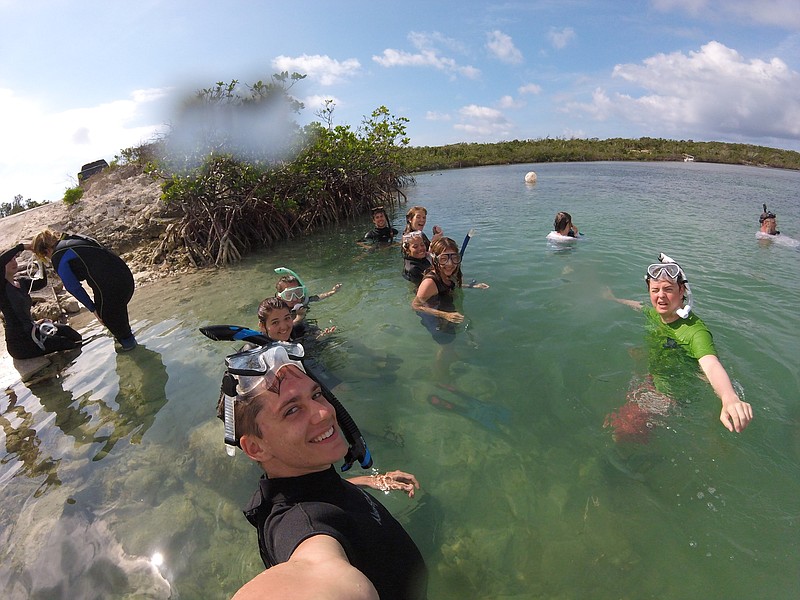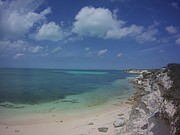Over the past 18 years, biologist Dawn Ford has been leading undergraduate research trips from the University of Tennessee at Chattanooga to San Salvador, Bahamas. A small-town girl raised in rural Horse Branch, Kentucky, Ford never imagined that her lifelong passion for the environment would one day open up the world for others.
Her father was a coal miner and her family owned a tobacco farm. As a girl, when Ford wasn't in school or tending to outdoor chores, she was furiously scribbling letters to her congressman about ammonia contamination from a nearby stone quarry and how it might affect local wildlife.
Ford is a lifelong environmentalist.
After high school, she studied biology at Western Kentucky University. Then, she pursued a master's degree in botany at Miami University in Oxford, Ohio. Prior to graduate school, Ford says, "I'd never been anywhere. I almost quit during my first semester because I was so homesick."
She'd never been on airplane - let alone out of the country - until 1993, when her graduate professor Hardy Eshbaugh invited her to join a research trip to Andros, a small undeveloped island in the Bahamas. The plane seated only six. Ford remembers sitting directly behind the pilot.
"I remember looking out and seeing the crystal-clear turquoise waters and I felt at ease," she says.
The following year, Ford returned to Andros Island to conduct research for her master's thesis, for which she studied coastal seaweed communities. Every day, Ford and her research partner would pack their lunch, boat to a different island and spend the afternoon snorkeling for samples. Once, they spotted a school of wild dolphins. Ford and her partner slipped out of the boat and joined the marine mammals for a swim.
Her time on the island was a life-changing experience, albeit, at times, uncomfortable.
"What put me outside my comfort zone the most was living in close quarters with other people for two weeks 24/7. We stayed in cabins that housed six to eight people and we shared a bathroom," says Ford.
In 1997, after receiving her doctorate degree in environmental health, Ford landed a teaching position at UTC. In 1998, she created a Bahamas Field Course for UTC students.
Every year since then, Ford has returned to the Bahamas, leading a group of 12 or so undergraduate students to San Salvador, a small island with a population of 1,000 located east of Andros. In 2013, UTC geologist Ann Holmes became a co-instructor to the class. The group bunks in Gerace Research Centre, a former Navy base converted into a field station. There is no air conditioning, no TV and no cellphone service.
"When I tell [the students] that, their eyes go wide. It's not for everyone," Ford says.
The first half of the semester is spent in Ford's classroom preparing the students for island life. They learn about the local population, the ecosystems and how to collect data. Then, in March, they fly to San Salvador where they spend one week conducting biological and geological research.
Each year, the projects change. This year, the focus was on how pond life was impacted by Hurricane Joaquin, a Category 4 storm that struck the Bahamas in 2015.
However, the purpose of the field course is more than just scientific. It is also meant to expand students' worldviews, as it did for Ford 23 years ago. Many of her students have never traveled abroad, she says.
"For a lot of people, it is the first time they'll snorkel, see a stingray or a barracuda. It scares them at first," says Ford.
In the past, the course was restricted to biology and geology majors. This year, it was opened up to students within UTC's Honors College, a selective program for high-achieving students. For the first time, the trip to San Salvador included accounting, psychology, history and English students, as well as two biology majors.
"I'll do accounting for the rest of my life. I won't have this experience again," says 20-year-old accounting student Ashton Mitchell, who had traveled abroad once before to visit Bahamian capital Nassau with her family. In contrast to that resort town, San Salvador boasts only a few remote shops. "So if you forgot your shampoo, you had to wait like three days before making the trip to town," she says.
For Mitchell's project, she and three other students studied Oyster Pond for changes in biodiversity following the hurricane. Their research determined a decline in algae species but an increase in the scaly pearl oyster population.
Next year, Mitchell plans to return to San Salvador to complete her senior thesis, a requirement for students in the Honors College, when she will continue to monitor Oyster Pond for post-hurricane changes to its biota and that oyster population.
"The [scaly pearl oyster] is really interesting. They can change sex multiple times during reproductive stages. More than biology, my interest is in gathering data," says Mitchell, whose dream job is to study analytics for the FBI.
Ford will accompany Mitchell back to the island. In fact, Ford returns to the island as often as she can. She says traveling to San Salvador is like traveling back in time. The island is wild and rural. Perhaps it boasts the same small-town simplicity Ford remembers from her hometown.
Regardless, it is an environment she will fight to protect through both science and - like she did as a girl - letter-writing.
Ford recounts her most recent trip home from San Salvador. Paging through an in-flight magazine, she came across an article advertising tours of the island's Pigeon Creek where a tourism company would catch green sea turtles so vacationers could pet them.
"Well that area is a national park and those turtles are endangered!" says Ford, who, somewhere over the Atlantic, promptly took out her notepad and pen and began furiously scribbling letters.
The findings
In previous years, UTC biology students outlined their own research projects. This year, because the Bahamas Field Course was open to non-majors, Ford and Holmes defined the projects, then allowed students to choose among three. Each group came up with a hypothesis, then spent time in the field collecting data which was then compared to data collected over the years by other UTC students in order to determine findings.Project 1“An examination of Hurricane Joaquin’s impact on red mangrove prop root biota of Oyster Pond in San Salvador, Bahamas”Students: Lauren Dunn, Ashlyn Pack, Alex Schwartz and Emily ShermanThe focus of this project was to study changes in large algae and invertebrate species attached to mangrove roots in Oyster Pond. The students collected samples along two transect lines, a method in which a string is laid across the habitat of study. Researchers then count the occurrence of species along that line to estimate the abundance of populations.Students also tested the water’s pH, salinity and nutrients.Their research concluded that while algal and invertebrate species are recovering, they are still less diverse and less abundant following the storm. Water chemistry showed little to no change.Project 2“A biotic survey of outcroppings in Oyster Pond after Hurricane Joaquin on San Salvador, Bahamas”Students: Jack Bogenschild, Mirel Crumb, Ashton Mitchell and Waverly RushingIn this project, students examined the effects of the hurricane on biota found in the pond outcroppings, which are an accumulation of growth consisting of algae, invertebrates and small fish. Samples were collected along three transect lines. Students also tested water chemistry, which showed a slight decrease in pH and a slight increase in salinity in contrast to data collected in 2015.Research findings also concluded a decrease in algal species’ richness and an increase in the scaly pearl oyster population.Project 3“[A study of] the effects of Hurricane Joaquin on the sediment of inland ponds on San Salvador, Bahamas”Students: Luke Black, Alexandra Durham, Sara Leach and Charlies StansberryIn contrast to Projects 1 and 2, which studied only Oyster Pond, this project surveyed six ponds through analysis of pond cores. Pond cores are collected by inserting a tube into pond sediment. The sediment is then examined for changes in grain size and species distribution.The students expected to find tempestite, rocks that show evidence of strong storm. No tempestites were observed. However, students did find broken shell hash in all but one pond. Still, their research did not conclude any observable connection between biodiversity and the pond’s proximity to the coast.
Lasting impact
In 2015, Ford and her former professor Hardy Eshbaugh administered a survey to 450 students from UTC and Miami University who had previously participated in the Bahamas Field Course. The purpose was to measure the impact of the course on students’ personal development, professional development and international perspective.97 percent agreed the course had a high impact on personal development.Top personal impacts were:» Exposure to/ immersion in Bahamian culture» Building relationships with peers, faculty and others» Hands-on experience/place-based education» Expansion of knowledge» International perspective (exposure to poverty)92 percent agreed the course had a high impact on professional development.Top professional impacts were:» Exposure to field work/field research» Working on a team» Applying and expanding their knowledge in the field» Learning new skills97 percent agreed the course is very important to the college experience.* Data collected from a 30 percent response rate)

